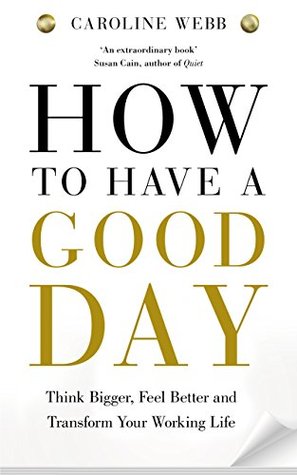More on this book
Community
Kindle Notes & Highlights
Read between
July 3 - December 4, 2019
ask my clients the same three questions: What does a good day look like for you? What about a bad one? What would it take to have more good days?
feeling productive,
knowing that their efforts counted toward something worthwhile.
feeling confident that they were doin...
This highlight has been truncated due to consecutive passage length restrictions.
support they needed fr...
This highlight has been truncated due to consecutive passage length restrictions.
good days leaving them feeling more energized...
This highlight has been truncated due to consecutive passage length restrictions.
www.howtohaveagoodday.com.)
psychology, behavioral economics, and neuroscience—
PSYCHOLOGY: GREATER FOCUS ON WELL-BEING
ECONOMICS: MORE REALISM IN THEORIES OF BEHAVIOR
NEUROSCIENCE: MORE SOPHISTICATED MEASUREMENT OF BRAIN ACTIVITY
“neuro-psycho-economics.”
The two-system brain:
one deliberate and controlled, the other automatic and instinctive.
The discover-defend axis:
constantly on the lookout for threats to defend against and rewards to discover.
not at our s...
This highlight has been truncated due to consecutive passage length restrictions.
The mind-body loop:
physical interventions can immediately boost our intellectual performance, emotional resilience, and personal confidence.
review some information, connect that information to our past experience, make sense of it all, generate options, and evaluate those options wisely.
“emotional regulation”—that is, not losing our cool when we’re upset—and to our ability to concentrate in the face of distractions.
responsible for planning—that is, setting goals and working out how to get there.
relies heavily on something called working memory.
hold information in our conscious mind as we figure out what to do with it.
switching from one task to another and back again.7 It gets tired pretty easily,
regularly rest and refuel our brain, the quality of our reasoning, self-control, and planning declines sharply.
its quick, automatic processes remove the
need for us to think consciously about every single thing we do. That frees up our deliberate system
autopilot routines.
doing multiple things in parallel,
shortcuts—which they call heuristics—
confirmation bias, groupthink, priming, and so on.
we don’t experience the world as it is; we’re always experiencing an edited, simplified version.
selective attention feature of the automatic system back
the value of having clear intentions.
Your deliberate system is responsible for sophisticated functions such as reasoning, self-control, and forward thinking.
But it has limited capacity and gets tired quickly.
Your automatic system lightens the load on your deliberate system by automating most of what you do
nobody ever experiences an entirely objective version of reality can lead to crossed wires and poor choices in the workplace.
creating the conditions for your deliberate system to function at its best, and recognizing when to slow down and come off autopilot.
THE DISCOVER-DEFEND AXIS
threat or a reward?”
we take steps to defend ourselves from the “threat,” or we embrace the “reward” with delight.
spend as little time as possible in defensive mode.
fight, flight, or freeze
speed often comes at the expense of accuracy. It’s as if they have a mantra of “better safe than sorry.”
brain powers up for that defensive response by shifting resources away from its sophisticated-but-slower deliberate system.
We can choke (freeze) when challenged, dissemble or tune out (flight) when we’re feeling out of our
depth, or snap (fight) at people when we’re feeling let down.


